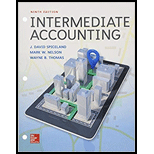
INTERMEDIATE ACCOUNTING(LL)-W/CONNECT
9th Edition
ISBN: 9781260216141
Author: SPICELAND
Publisher: MCG CUSTOM
expand_more
expand_more
format_list_bulleted
Concept explainers
Textbook Question
Chapter 7, Problem 7.20Q
(Based on Appendix 7B) Marshall Companies, Inc., holds a note receivable from a former subsidiary. Due to financial difficulties, the former subsidiary has been unable to pay the previous year’s interest on the note. Marshall agreed to restructure the debt by both delaying and reducing remaining cash payments. The concessions impair the creditor’s investment in the receivable. How is this impairment recorded?
Expert Solution & Answer
Want to see the full answer?
Check out a sample textbook solution
Students have asked these similar questions
Goodwill is an example of an indefinite-life intangible asset, meaning that public companies must test it for impairment rather than regularly amortizing to systematically reduce its value on the balance sheet of the public company.
Can anyone recap the difference between limited-life versus indefinite-life intangible assets? Any specific examples of either category?
Why are adjusting journal entries necessary at the end of an accounting period? Need he
Why are adjusting journal entries necessary at the end of an accounting period?i need help
Chapter 7 Solutions
INTERMEDIATE ACCOUNTING(LL)-W/CONNECT
Ch. 7 - Prob. 7.1QCh. 7 - Prob. 7.2QCh. 7 - Prob. 7.3QCh. 7 - Prob. 7.4QCh. 7 - Prob. 7.5QCh. 7 - Prob. 7.6QCh. 7 - Distinguish between the gross and net methods of...Ch. 7 - Briefly explain the accounting treatment for sales...Ch. 7 - Explain the typical way companies account for...Ch. 7 - Briefly explain the difference between the income...
Ch. 7 - Prob. 7.11QCh. 7 - Is any special accounting treatment required for...Ch. 7 - Explain any possible differences between...Ch. 7 - Prob. 7.14QCh. 7 - What is meant by the discounting of a note...Ch. 7 - What are the key variables that influence a...Ch. 7 - Explain how the CECL model (introduced in ASU No....Ch. 7 - Prob. 7.18QCh. 7 - Prob. 7.19QCh. 7 - (Based on Appendix 7B) Marshall Companies, Inc.,...Ch. 7 - Prob. 7.21QCh. 7 - Prob. 7.1BECh. 7 - Prob. 7.2BECh. 7 - Prob. 7.3BECh. 7 - Cash discounts; gross method LO73 On December 28,...Ch. 7 - Prob. 7.5BECh. 7 - Sales re turns LO74 During 2018, its first year...Ch. 7 - Sales re turns LO74 Refer to the situation...Ch. 7 - Prob. 7.8BECh. 7 - Prob. 7.9BECh. 7 - Uncollectible accounts; balance sheet approach ...Ch. 7 - Uncollectible accounts; solving for unknown LO75,...Ch. 7 - Prob. 7.12BECh. 7 - Note receivable LO77 On December 1, 2018,...Ch. 7 - Long-term notes receivable LO74 On April 19,...Ch. 7 - Prob. 7.15BECh. 7 - Factoring of accounts receivable LO78 Refer to...Ch. 7 - Prob. 7.17BECh. 7 - Discounting a note LO78 On March 31, Dower...Ch. 7 - Receivables turnover LO78 Camden Hardwares credit...Ch. 7 - Prob. 7.20BECh. 7 - Prob. 7.21BECh. 7 - Impairments of Accounts Receivable Appendix 7B...Ch. 7 - Credit Losses on Accounts Receivable (CECL Model) ...Ch. 7 - Prob. 7.1ECh. 7 - Prob. 7.2ECh. 7 - Prob. 7.3ECh. 7 - Prob. 7.4ECh. 7 - Trade and cash discounts; the gross method and the...Ch. 7 - Prob. 7.6ECh. 7 - Cash discounts; the net method LO73 [This is a...Ch. 7 - Sales returns LO74 Halifax Manufacturing allows...Ch. 7 - Prob. 7.9ECh. 7 - Prob. 7.10ECh. 7 - Uncollectible accounts; allowance method; balance...Ch. 7 - Uncollectible accounts; allowance method and...Ch. 7 - Uncollectible accounts; allowance method; solving...Ch. 7 - Note receivable LO77 On June 30, 2018, the...Ch. 7 - Noninterest-bearing note receivable LO77 [This is...Ch. 7 - Long-term notes receivable LO77 On January 1,...Ch. 7 - Prob. 7.17ECh. 7 - Prob. 7.18ECh. 7 - Prob. 7.19ECh. 7 - Factoring of accounts receivable with recourse ...Ch. 7 - Factoring of accounts receivable with recourse...Ch. 7 - Discounting a note receivable LO78 Selkirk...Ch. 7 - Concepts; terminology LO71 through LO78 Listed...Ch. 7 - Receivables; transaction analysis LO73, LO75...Ch. 7 - Prob. 7.25ECh. 7 - Prob. 7.26ECh. 7 - Prob. 7.27ECh. 7 - Prob. 7.28ECh. 7 - Prob. 7.29ECh. 7 - Prob. 7.30ECh. 7 - Impairments of Notes Receivable Appendix 7B At...Ch. 7 - Prob. 7.32ECh. 7 - Prob. 7.33ECh. 7 - Prob. 7.34ECh. 7 - Uncollectible accounts; allowance method; income...Ch. 7 - Uncollectible accounts; Amdahl LO75 Real World...Ch. 7 - Bad debts; Nike, Inc. LO75 Real World Financials...Ch. 7 - Uncollectible accounts LO75, LO76 Raintree...Ch. 7 - Prob. 7.5PCh. 7 - Notes receivable; solving for unknowns LO77...Ch. 7 - Prob. 7.7PCh. 7 - Prob. 7.8PCh. 7 - Prob. 7.9PCh. 7 - Prob. 7.10PCh. 7 - Prob. 7.11PCh. 7 - Accounts and notes receivable; discounting a note...Ch. 7 - Prob. 7.13PCh. 7 - Prob. 7.14PCh. 7 - Prob. 7.15PCh. 7 - Prob. 7.16PCh. 7 - Prob. 7.17PCh. 7 - Prob. 7.1BYPCh. 7 - Prob. 7.2BYPCh. 7 - Prob. 7.3BYPCh. 7 - Real World Case 74 Sales returns; Green Mountain...Ch. 7 - Ethics Case 75 Uncollectible accounts LO75 You...Ch. 7 - Prob. 7.6BYPCh. 7 - Prob. 7.7BYPCh. 7 - Prob. 7.8BYPCh. 7 - Prob. 7.9BYPCh. 7 - Prob. 7.10BYPCh. 7 - Prob. 7.11BYPCh. 7 - Prob. 1CCTC
Knowledge Booster
Learn more about
Need a deep-dive on the concept behind this application? Look no further. Learn more about this topic, accounting and related others by exploring similar questions and additional content below.Similar questions
arrow_back_ios
SEE MORE QUESTIONS
arrow_forward_ios
Recommended textbooks for you
 Intermediate Accounting: Reporting And AnalysisAccountingISBN:9781337788281Author:James M. Wahlen, Jefferson P. Jones, Donald PagachPublisher:Cengage LearningPrinciples of Accounting Volume 1AccountingISBN:9781947172685Author:OpenStaxPublisher:OpenStax College
Intermediate Accounting: Reporting And AnalysisAccountingISBN:9781337788281Author:James M. Wahlen, Jefferson P. Jones, Donald PagachPublisher:Cengage LearningPrinciples of Accounting Volume 1AccountingISBN:9781947172685Author:OpenStaxPublisher:OpenStax College


Intermediate Accounting: Reporting And Analysis
Accounting
ISBN:9781337788281
Author:James M. Wahlen, Jefferson P. Jones, Donald Pagach
Publisher:Cengage Learning

Principles of Accounting Volume 1
Accounting
ISBN:9781947172685
Author:OpenStax
Publisher:OpenStax College


Chapter 19 Accounting for Income Taxes Part 1; Author: Vicki Stewart;https://www.youtube.com/watch?v=FMjwcdZhLoE;License: Standard Youtube License